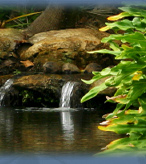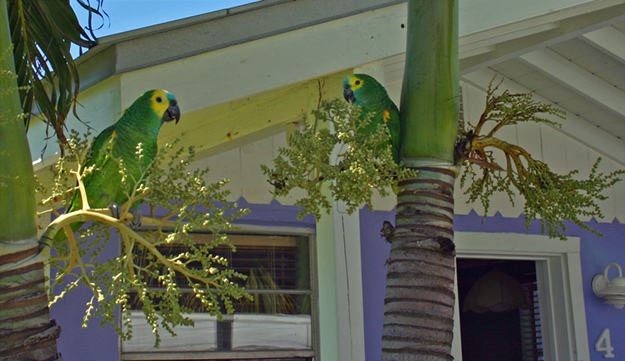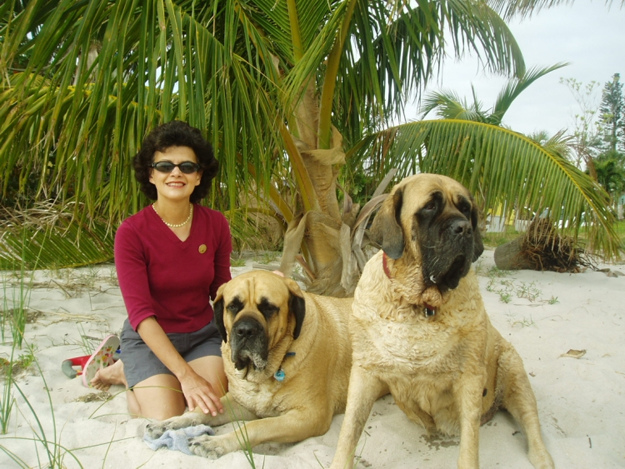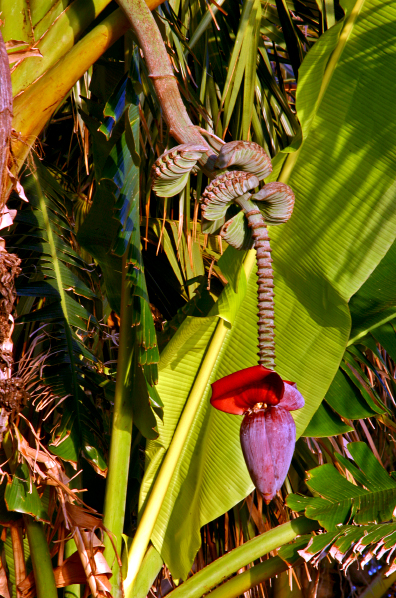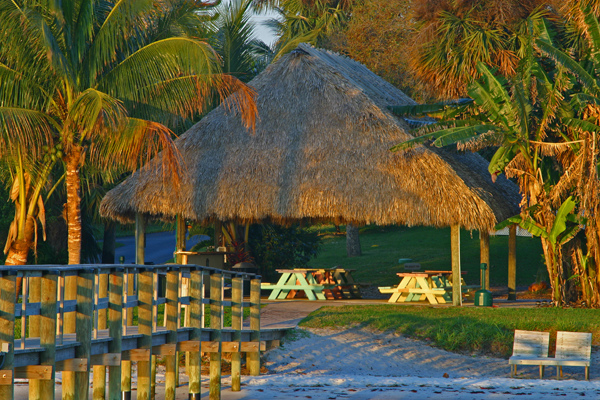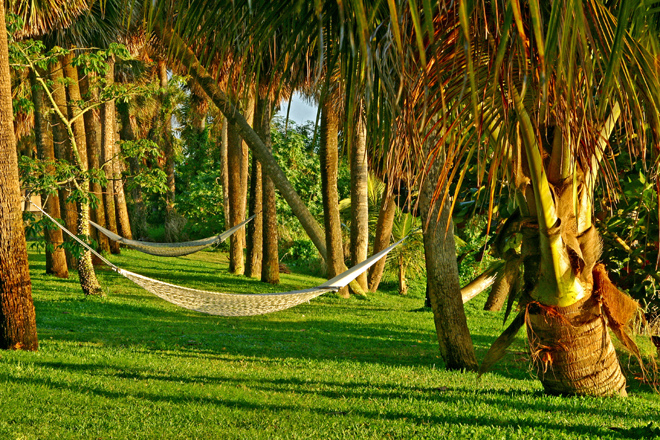Bush with short green leaf tips. Used in salads & stir-fries.
Tastes like fresh green pea pods.
Evergreen vine, leaves are poisonous when eaten.
Pimiento-Evergreen 9' to 40’, the fruit is picked green &
dried to produce the combined flavors of nutmeg, cloves and cinnamon.
Allspice is the dried unripe fruit.
Withstands salts spray. Flat almond shape edible fruits.
Cleansing properties, excellent on burns.
(Golden apple) rapid growing up to 40’. Deciduous long stalk
fruits, dangle in bunches of a dozen or more, 2 ½-3 ½”.
With thin tough skin. Flesh is crisp with a pineapple like fragrance
& flavor. Fruits fall to midwinter. * The wood is light and
buoyant and has been used for canoes.
known as vegetable butter. Evergreen 30-60 feet in height, pollinated
by bees. Many isolated trees fail to fruit from lack of pollination.
Will not ripen while still attached to the tree, mature fruits will
ripen in 1-2 weeks @room temperature. The fruit skin is antibiotic,
because the high tannin content of the seeds they were used for
ink to write many documents in the days of the Spanish conquest.
Member of the grass family, some varieties are used for building
furniture, fish poles and scuffling.
20 varieties, herbaceous, 5-25 inches height, very succulent flower
when 12-18 months old, it takes 3 months for the flower to fruit.
Bananas are staple foods for most tropical countries and constitute
the 4th. Largest fruit crop of the world. Fully-grown fruits in
each cluster are called a hand; they usually produce one leaf per
month in winter and 4 per month in summer.
Up to 15’ evergreen bushy growth. Red to scarlet fruit approx.
1” with apple flavored flesh, very rich in vitamin C, Dried
preparation are sold commercially as Acerola. Favorite of the children.
Season May-Nov. Sparsely most of the year.
(chocolate pudding) closely related to persimmon, slow growing up
to 80’, fruit is olive green to muddy when ripe. Flesh is
glossy brown to almost black jelly like, soft, sweet and mild in
flavor. Often seedless close to stewed prunes, in Florida most ripen
Dec through Jan. Mixed with cool whip resembles chocolate mousse.
Season Nov-April.
Shrub fruit early summer, Florida varieties are available.
Core used for hearts of palm in salads: It is the Florida State
tree!
(Star Apple) Nearly evergreen 25 to 100’ tall, golden leaf
tree, short trunk with a large crown. Leaves are green on top and
rusty underneath. Fruit is 2-4” diameter, either purple or
green & pulp is soft and milky white and sweet, Star apples
must not be bitten into the skin and rind are inedible & extremely
bitter. These are picked by clipping the stem. “Cuban residents
in Miami are known to seek the leaves in order to administer the
decoction as a cancer remedy. Season is from Feb- to May.
6 ½-25’ prized more for its ornamental value than fruits.
Evergreen and cold hardly, makes excellent marmalade and it is great
in ice tea & cocktails. Other uses include as a deodorant and
when rubbing the juice on insect bites relieves itching and irritation,
it also bleaches freckles and helps clear acne.
from Panama. With branches close to the ground and has a 1-3 foot
long candle like fruit, they have a waxen texture and resemble hand
dipped candles. These trees also have a pungent apple-like fragrance.
Evergreen up to 25’. Oval fruit from 3-5” & 2-3
wide, when ripe the skin turns yellow, smooth & glossy. Flesh
is firm, mealy, softer & pastier in the middle (likened in texture
to yolk of hard boiled eggs); flavor is sweet, musky somewhat like
a baked sweet potato. Very rich in carotene + niacin. Season is
Sept.-March, Fruits in Dec - March.
Slow growing, many branches with a rounded crown reaching 20-30’.
Slices cut in cross section have the form of a star, not particular
to soil but needs moisture for best performance. Mature trees can
tolerate freezing for short periods. In Florida scattered fruits
are found through the year with main crop late summer to early winter.
Excellent in salads, garnish, puddings and pies, substitute Carambola
for apple pie, MMM!! DELICIOUS, the juice will also bleach rust
stains from white cloth.
Small Evergreen, native to Brazil up to 15’ tall. Fruit is
dark red up to 1”, season from April to June.
Up to 100’, one of the world’s chief sources of vegetable
fat. The coconut will germinate ever after floating in the ocean
4 months!
Shrub, fruit is up to 1” has dark to purple skin, white spongy
flesh, rather bland, kids like them.
An evergreen shrub grown in the tropics for coffee beans and house
plants elsewhere, up to 15’ tall, ½” berries
that turn red when ripe, fleshy pulp is removed, the beans dried,
shelled & graded, stared to season, then roasted.
A Perennial grown commercially in the tropics, in Hawaii and the
Pacific the root is eaten in the form of “poi”.
Fruits throughout the year, ½” black when ripe. Kids
love them! Great in jams & cobblers.
Deciduous 10-30’ with numerous spreading branches. Needs no
pollination, fruit is juicy & sweet. Fresh & dried have
laxative action. Season early summer to fall.
(clustered) Up to 40’. Outer coat is poisonous causing irritation
to the skin. When each trunk finishes flowering and fruiting it
will die.
Low chilling requirements, tree is dwarf and deciduous, flesh is
mainly white. Season late April-June.
An essence prepared from the flowers has been made to overcome insomnia.
Highly ornamental, fruit is ½ -3/4”, dark purple when
ripe, red or white pulp tastes very much like a tree cherry. Better
suited for subtropical climate. Quick period from flower to fruit,
usually one month. Season April-June.
Shrub or small tree, Fla. Height 20’ by 20’ wide, bark
reddish- brown flakes off. Fruit is roundish yellow to bright red
with many seeds. Eaten out of hand but preferred seeded as dessert
or in salads. Lots of medicinal uses. Season July-Sept.
Up to 60’, deciduous, light reddish brown flaking bark. Excellent
salt tolerance. * A limb of any size stuck in the ground will grow.
Up to 10’, small tree of unusual form. Fruit dull orange to
yellow. 1 ½-2” across. Have thin skin, one seed, and
thin watery pulp. Eaten fresh. Season July-Aug.
Member of the myrtle family. Native to Brazil. Slow growing Evergreen
up to 20’. Flowers form on the trunk and fruit, smooth with
a tough dark purple skin and a gelatinous pulp grapelike flavor.
Will not bear fruit for 8-15 years. Trees in South Florida usually
bear 2 times per year. Mostly eaten out of hand. Excellent jelly,
(one of Melynda’s favorites). Season 5-6 crops a year. 1 month
from flower to fruit.
Fern tree, cool blue blossoms. Up to 60’, usually deciduous
for a short time before bloom, in northern Argentina it is commonly
used for lumber.
Handsome 30-70’ tall, Evergreen. Largest of all tree born
fruits. May be 8” to 3’/6-20” wide and weigh 10-60
and up to 110lbs! The rind or yellow when ripe, inside consists
of large bulbs of yellow banana flavor flesh, when fully ripe the
unopened fruit emits a strong odor resembling decayed onions, but
the pulp smells of pineapple-banana. In Florida fruit ripen in late
summer and fall. The seeds may be boiled or roasted & eaten.
“Roasted are regarded as an aphrodisiac”. The heated
latex is used as household cement for mending china and to caulk
boats. Termite proof wood superior to teak for furniture.
also called Ceiba tree & God tree. A large tropical tree often
exceeding a 100’. Leaf shaped like human hands and has 5-9
fingers, this shed in winter, greenish white flowers are borne while
the tree is bare of leaves; seed pods are shaped like a sweet potato
and filled with small hard pea shaped cotton covered seeds. The
floss called kapok used to stuff mattresses, pillows, life preserves
& upholstery. One of the largest trees in tropical America.
Trunk can reach 6-10’. Thrives in South & Central Florida.
Small thorny tree up to 15’. Usually used while skin is still
green to slightly yellow. Famous in pies, fairly salt tolerant.
Season late fall-spring.
Little gems of citrus. Slow growing shrubby up to 15’. MEIWA-
large round, often seedless to few seeds. Sweet, frequently thornless.
NAGAMI- The most often cultivated in Florida, oval. In season Oct.-Jan.
Evergreen, slow growing, erects ornamental 20-50’, dark bark.
Fruits are 1-2” with velvety, brownish, thin, tender skin.
The pulp is orange-red soft with a sub-acid flavor.
Leading acid citrus fruit up to 20’. Flowers are larger &
showier than the orange most vigorous of the citrus family, respond
well to pruning & should be cut back to keep compact & fruit
in reach.
Close relative of the lychee, handsome Evergreen. Reaching 30-40ft.
With a rounded crown. Fruits in drooping cluster ½ to 1”
in diameter with thin brownish pebbled skin. Flesh is whitish, translucent,
usually eaten fresh out of hand. Endures more frost than lychee.
In China they are canned in syrup or dried. Season July-Aug.
Also known as Japanese or Asian plum, 25’. Fruit 1-3”
long. Yellow to orange velvety skin. Fruits Jan-April. Delicious
in a pie. It tastes just like cherry pie.
Litchi nut, native of China, slow growing Evergreen 30-100’.
Fruits in clusters of 2-30, usually strawberry red, leathery warty
skin which is easily peeled. Flesh is translucent-white and very
grape like. The flesh of dried lychees is eaten like raisins, fruits
mid June to July.
Evergreen up to 40’& almost as wide, bears fruit in 4-6
years. Rapidly growing bears very hard-shelled nuts, grown commercially
in Florida & Hawaii. Season Nov-March, 6-7 months from flower
to fruit.
Fast growing, Evergreen up to 40’, fruit is oblong or bell
shaped, has thin, smooth waxy skin, red to pink in color, juicy
flesh of mild sweet flavor, (very tropical).
Evergreen, handsome, some say resembles the Southern Magnolia. Reaches
60-70’, fruit nearly round ranges from 4-8”. Hard until
fully ripe. Skin is light brown & scurfy. Flesh is light to
golden yellow, non-fibrous and varies from crisp to tender &
juicy. Resembles the apricot or red raspberry in flavor. Dr. Talmadge
Wilson of Stuart had one that reached 30’, but was killed
by lightning. Protection from cold 1st. few winters, then adapts
well. Should be clipped leaving portion of stem on tree.
The apple of the tropics. Long lived. Some specimens have been known
to be 300 years old and still fruiting, 30’ to 100’.
Flesh ranges from pale-yellow to deep orange, extremely juicy, ranging
from very sweet to sub-acid to tart. Not particular to soil type
as long as it has good drainage. They normally reach maturity 4-5
months from flowering. HADEN- 90% of all commercial production *CARRIE-
Somewhat dwarf. Most young trees less than 10 years old, may fruit
every year. Thereafter most tend to bear every other year. Mangos
should be washed before handling the sap is a potent skin irritant
and capable of blistering the skin, swelling of eyelids, face etc…
does make excellent puree poured over angel food cake, served with
fresh raspberry mint. (Melynda’s favorite light dessert).
Season May-Oct.
Small cranberry shapes. One fruit eaten will halt the bitter taste
buds up to 1 hour; a lime if bitten into will taste sweet.
Hug Plum, deciduous fruits are somewhat plum like and vary 1-2”
in length. Skin is glossy and firm, the flesh is yellow fibrous
and juicy. Cold sensitive can propagate by setting large cuttings
in ground used to create living fences. Ripe fruits commonly eaten
out of hand. The tree is known to exude a gum that has served in
Central America as glue.
(ceriman) fast growing herbaceous vine climbs trees up to 30’.
Calla lily like, develops into a green compound fruit 8-12”
in length, scales cover segments of ivory colored fruit much like
diced pineapple. 12-14 months to mature. * The aerial roots have
been used as ropes in Peru. *In Martinique a preparation of the
root is used as a remedy for snakebite.
Slow growing to 33’, young branches are densely coated with
russet hairs, usually leaves are glossy on top and hairy underside.
Fruit is peculiarly odorous, orange-yellow thin skin white juicy
pulp. Varying from sweet to acid. Highly drought tolerant. Soda
pop fruit, Island children add them to a bottle of water for beverage.
It is perishable when ripe but can be stored for several months
by merely keeping semerged in water.
Herb & stout trunk up to 15’, male flower are fragrant
and on long stalks, female are directly on trunk. Pollination is
done by sphinx moths. Trees may bear fruit for 20 years usually
2-3. It weighs from ½ lb. To 20 lbs. Melon like, yellow orange
flesh. Proposate & seeds.
Vine climbing by means of tendrils. Flower is very showy, especially
that of the yellow, round fruit is ½-3” wide, pulpy
juice with as many as 250 seeds, flavor is guava like. Australians
eat seeds and all but elsewhere it is usually squeezed through cheesecloth
or pressed through a strainer. Medicinal uses currently a revival
of interest in the pharmaceutical industry in Europe as a sedative
or tranquilizer. Season summer to mid-winter.
deciduous compact trees up to 25’, fruit up to 3” with
orangish-red skin. Fuyu is non-astringent medium sweet flavor. Fruits
Sept-Oct. bears in 4-5 years. When the leaves drop, the fruit dangles
on bare branches. Season summer- early fall.
A terrestrial herb, Caribbean islands placed pineapples & crowns
outside entrances to their homes as symbols of friendship &
hospitality. It has become one of the leading commercial fruit crops.
*When the industry was flourishing Florida, shipped one million
crates per year from the sandy ridge along the Indian River in the
early 1900’s. Season May-Sept. usually after 15-312 months.
Dense slow growing evergreen, fruit 1-11/4 long, bright orange-yellow.
Apricot-like in texture. Season May-July.
Small bush with many stems. Rarely over 15’. Fruit may be
up to 5”; seeds are covered with a sweet gelatinous reddish
pulp. Fruits all year in South Florida. Beautiful red flower.
The largest citrus fruit, Fruit ranges from 4-12” wide. Usually
grown from curiosity, flowers are large and highly aromatic also
used for making perfume.
Highly ornamental, Evergreen, very strong, wind resistant and can
stand salt spray, slow growing up to 60’, sub-tropical can
stand a short freeze. Fruit is round to oval from 2-4 inches in
width. Brown smooth skin with sweet yellow to brown flesh pear-like
in consistency. Fruits from may- Sept. with peak in June/July. Chicle.
- The gummy latex contains 15% rubber and 38% resin and for many
years has been the chief ingredient in chewing gum. The latex is
also used in the tropics as crude filling for tooth cavities. The
trees can be tapped every two years yielding about 50 quarts of
latex chicle the original base for chewing gum. Season May-Aug.
Some all year.
Evergreen or deciduous, erect frequently 60’ but can reach
130’, fruit round to ovoid, rough dark-brown, firm, leathery
skin to fleshy which is salmon pink to deep red, soft, sweet and
pumpkin like in flavor, eat out of hand, yummy in sherbet. Fruit
season May-July.
Up to 20’ leaves up to 6’ long, used by natives for
weaving baskets & mats. The fruit is round about 6” across,
green & yellowing as it ripens with a small amount of edible
pulp. Salt tolerant.
Salt tolerant, yummy in jelly. Flowering season May, green fruit
turning purple Sept. Oct.
Jamaican cherry, Evergreen, fast growing, nicknamed strawberry tree
because it blooms resemble “blossoms” small fruits eaten
whole. Fruits nearly year round. Wood is valued for fuel in Jamaica;
it ignites quickly, burns with intense heat and gives off very little
smoke. Season all year on mature trees.
“white”, deciduous 10-20’, mostly widely grown
species of annona. Nearly round fruit with knobby segments and a
creamy sweet white flesh. Best as a fresh fruit. Season Aug-winter.
Brazilian cherry, shrub or tree up to 25’. In Florida is the
most common hedge plant throughout central and southern pants of
the state. Bright red to almost black when mature, there are 2 distinct
types: The black crimson tends to be much sweeter & less resinous.
Spring & fall crops in Fla. In Brazil the leaves have been spread
over the floors of homes, when walked on them, they release pungent
oil, which repels flies. Season May-June and sporadic all year.
Slow growing long lived up to 80’ and spread up to 40’!
Leaves fold at night. Fruits are flat; bean like curved with bulged
pod. Used as a paste, beverage candy and preserves. Withstands salt
sprays. Florida fruits Dec-Jan. and ripens April-June.
Up to 30’, fan shaped. Banana shaped leaves. The large hollow
leaf stalks form receptacles, which store a quart of water.
Large spreading shrub, fruit has velvety brownish thin skin and
a soft flesh resembling apricot. Fruit season Dec. Apr.
It’s an orchid – bean life fruit used in flavoring.
(Java-apple) Short trunk widespreading crown. 16-50’, pinkish-gray
flaking bark. Fruit has a waxy skin, usually light red sometimes
greenish-white, pear shaped. Thin skinned, flesh is white, spongy
dry to juicy and bland in flavor. The leaves are very aromatic when
crushed, very fragrant flower.
Flower used to scent Chanel perfume.
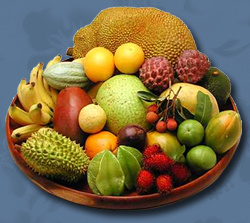
|

![]()




